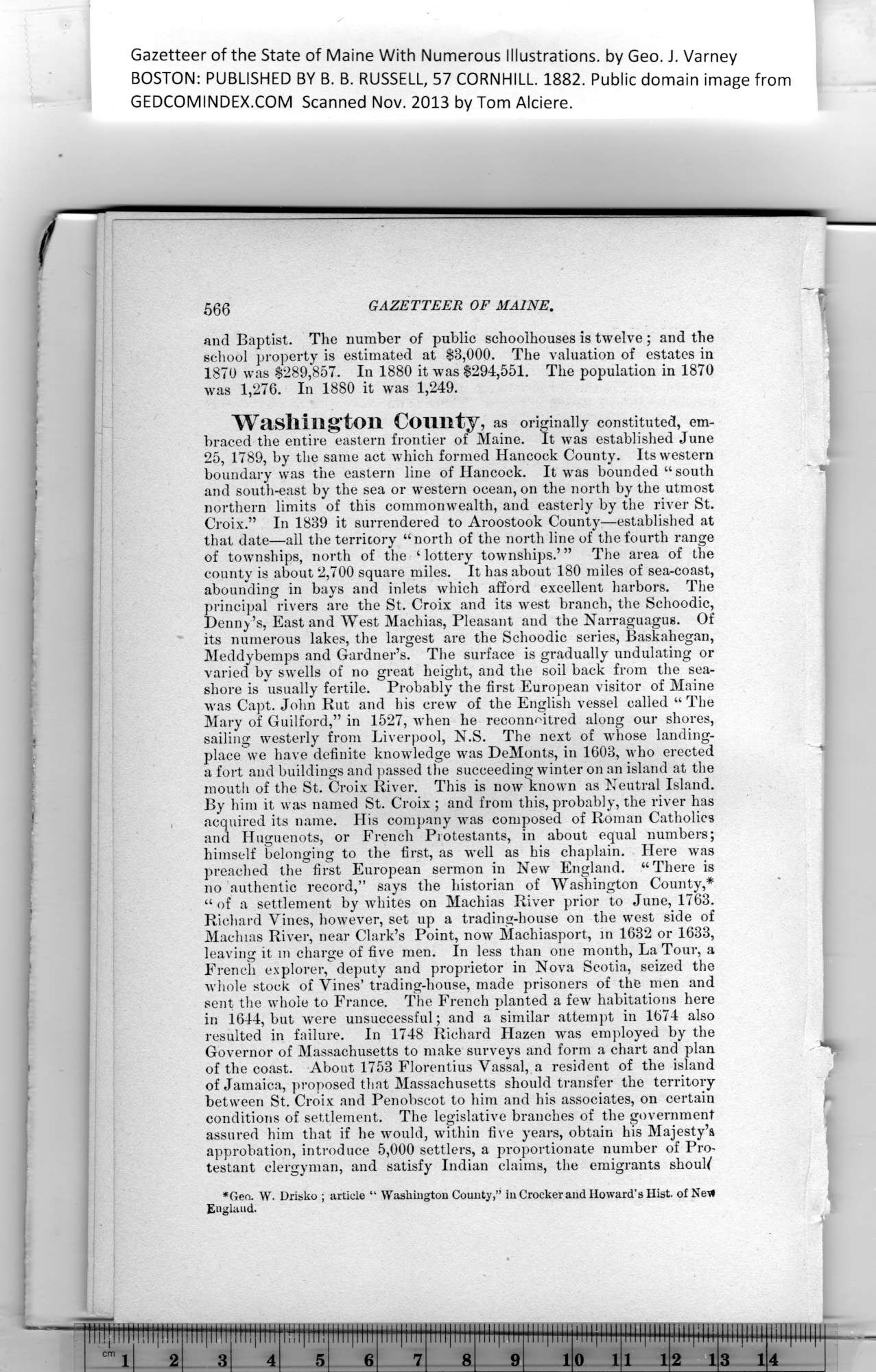|
Gazetteer of the State of Maine With Numerous Illustrations, by Geo. J. Varney
BOSTON: PUBLISHED BY B. B. RUSSELL, 57 CORNHILL. 1882. Public domain image from
566 GAZETTEER OF MAINE.
and Baptist. The number of public schoolhouses is twelve ; and the
school property is estimated at $3,000. The valuation of estates in
1870 was $289,857. In 1880 it was $294,551. The population in 1870
was 1,276. In 1880 it was 1,249.
Washington County, as originally constituted, em-
braced the entire eastern frontier of Maine. It was established June
25, 1789, by the same act which formed Hancock County. Its western
boundary was the eastern line of Hancock. It was bounded “south
and south-east by the sea or western ocean, on the north by the utmost
northern limits of this commonwealth, and easterly by the river St.
Croix.” In 1839 it surrendered to Aroostook County—established at
that date—all the territory “north of the north line of the fourth range
of townships, north of the ‘ lottery townships.’ ” The area of the
county is about 2,700 square miles. It has about 180 miles of sea-coast,
abounding in bays and inlets which afford excellent harbors. The
principal rivers are the St. Croix and its west branch, the Schoodic,
Denny’s, East and West Machias, Pleasant and the Narraguagus. Of
its numerous lakes, the largest are the Schoodic series, Baskahegan,
Meddybemps and Gardner’s. The surface is gradually undulating or
varied by swells of no great height, and the soil back from the sea-
shore is usually fertile. Probably the first European visitor of Maine
was Capt. John Rut and his crew of the English vessel called “ The
Mary of Guilford,” in 1527, when he reconnoitred along our shores,
sailing westerly from Liverpool, N.S. The next of whose landing-
place we have definite knowledge was DeMonts, in 1603, who erected
a fort and buildings and passed the succeeding winter on an island at the
mouth of the St. Croix River. This is now known as Neutral Island.
By him it was named St. Croix ; and from this, probably, the river has
acquired its name. His company was composed of Roman Catholics
and Huguenots, or French Protestants, in about equal numbers;
himself belonging to the first, as well as his chaplain. Here was
preached the first European sermon in New England. “There is
no authentic record,” says the historian of Washington County,1
“of a settlement by whites on Machias River prior to June, 1763.
Richard Vines, however, set up a trading-house on the west side of
Machias River, near Clark’s Point, now Machiasport, in 1632 or 1633,
leaving it m charge of five men. In less than one month, La Tour, a
French explorer, deputy and proprietor in Nova Scotia, seized the
whole stock of Vines’ trading-house, made prisoners of the men and
sent the whole to France. The French planted a few habitations here
in 1644, but were unsuccessful; and a similar attempt in 1674 also
resulted in failure. In 1748 Richard Hazen was employed by the
Governor of Massachusetts to make surveys and form a chart and plan
of the coast. About 1753 Florentius Vassal, a resident of the island
of Jamaica, proposed that Massachusetts should transfer the territory
between St. Croix and Penobscot to him and his associates, on certain
conditions of settlement. The legislative branches of the government
assured him that if he would, within five years, obtain his Majesty’s
approbation, introduce 5,000 settlers, a proportionate number of Pro-
testant clergyman, and satisfy Indian claims, the emigrants sboul/
1
Geo. W. Drisko ; article “ Washington County,” in Crocker and Howard’s Hist, of New
England.
PREVIOUS PAGE ... NEXT PAGE
This page was written in HTML using a program written in Python 3.2
|
